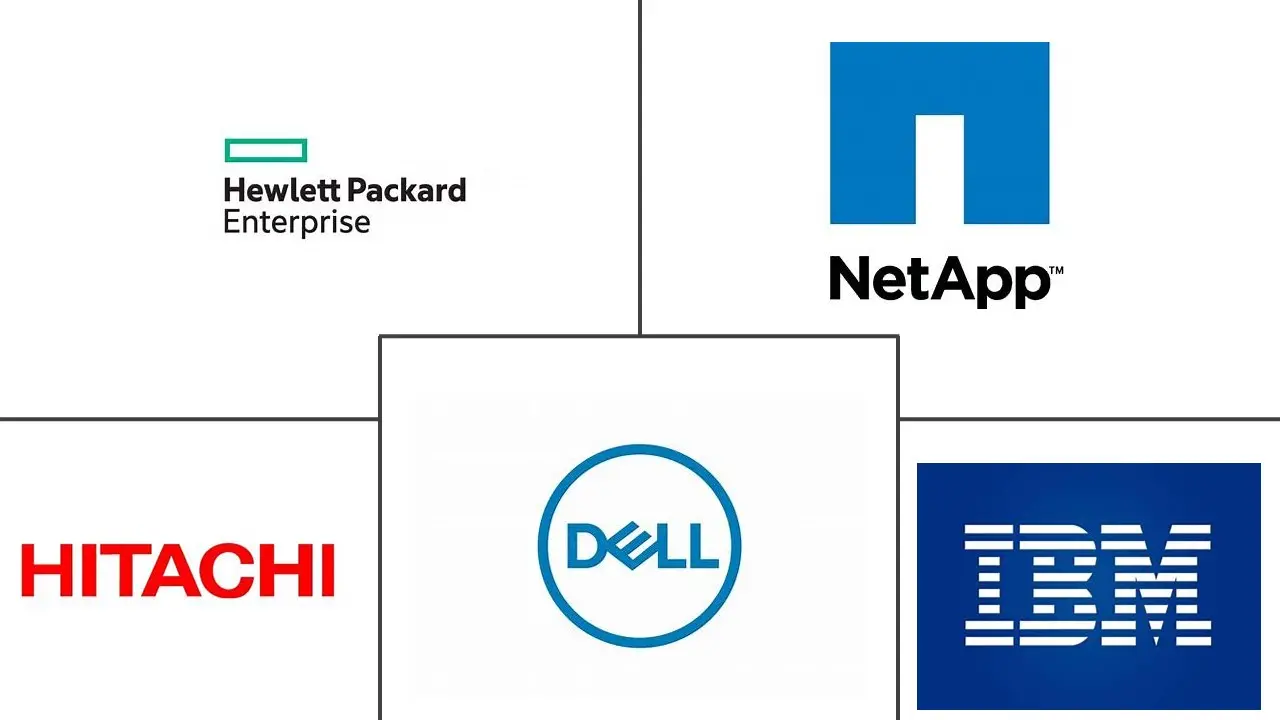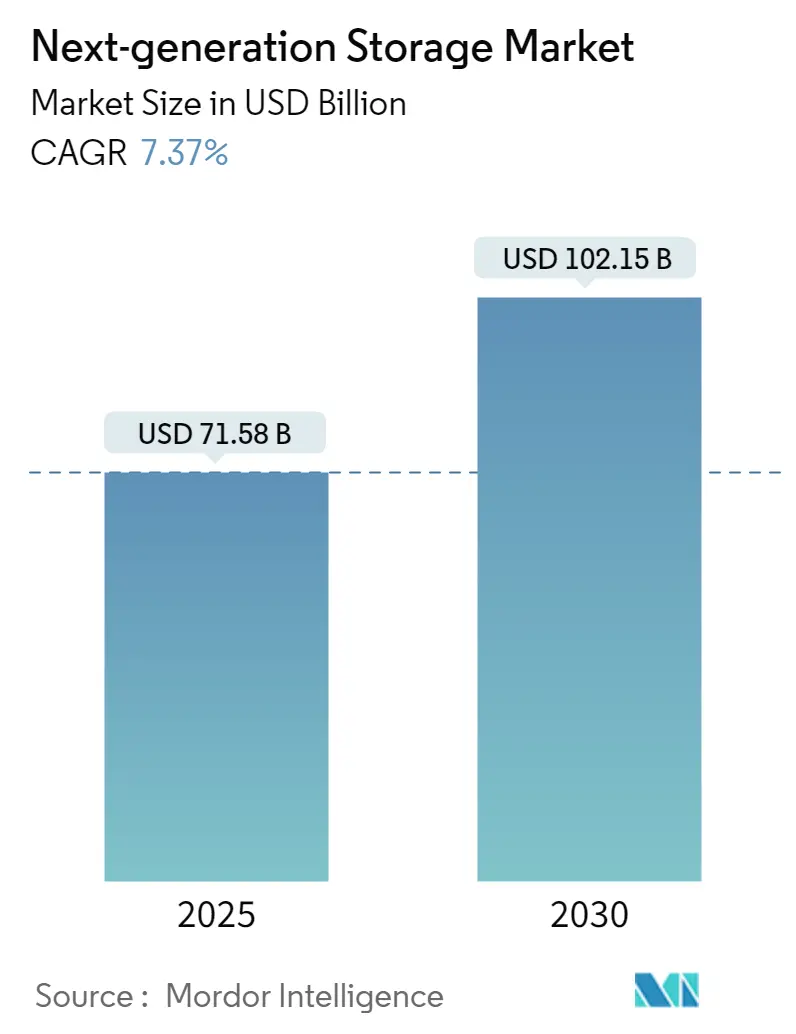
Next-generation Storage Market Analysis by Mordor Intelligence
The Next-generation Storage Market size is estimated at USD 71.58 billion in 2025, and is expected to reach USD 102.15 billion by 2030, at a CAGR of 7.37% during the forecast period (2025-2030).
With the sizeable and exponential growth in the digital world, there has been an accelerating development in mobile services, Big Data, cloud computing, and social networking applications. Next-generation storage technology deals with an advanced portfolio of products and solutions, which help store data across various end-user industries, including IT firms, automotive companies, and data centers. With the increasing file sizes and a massive amount of unstructured and Big Data, IT companies face plenty of problems while dealing with data management.
- Conventional data storage technologies cannot handle a large amount of everyday data. The next-generation data storage infrastructure offers a reliable, faster, and cost-effective solution to meet the growing data storage demands.
- Further, the next-generation storage technology market is moving into the information technology sector, with an extensive range of applications across Big Data storage, enterprise data storage, and other cloud-based services. Storage and how it is addressed can significantly impact the top and bottom lines. IT organizations are expected to be more willing to move from making a safe storage investment to investing in new technologies that can benefit the business.
- In April 2023, VAST Data announced that Hewlett Packard Enterprise (HPE) had incorporated VAST Data's leading file software platform into the new HPE GreenLake for File Storage service. By leveraging VAST's unique and innovative scale-out software architecture for the new HPE GreenLakefor File Storage, enterprise customers can manage unstructured data with massive performance and achieve faster data insights.
- However, many security issues are associated with cloud-based storage, such as misconfiguration, insufficient data governance, and poor access controls, among others. Such cloud storage security issues that can expose enterprise data to unauthorized parties can act as a restraint on market growth.
- The COVID-19 pandemic outbreak positively impacted the next-generation storage market, especially solutions used in cloud storage. Storage vendors were making some of their hardware and software technology available for free to help researchers, businesses, work-from-home users, and partners run their businesses and work remotely during the COVID-19 coronavirus pandemic.
Global Next-generation Storage Market Trends and Insights
Direct Attached Storage (DAS) to Witness Significant Growth
- Direct Attached Storage (DAS) is the oldest and most conventional data storage system connected directly to a computer, such as a PC or server, unlike other storage systems connected to a computer over a network.
- DAS offers specific benefits compared to other storage systems that play an essential role in many organizations' storage strategies: high performance, easiness during the setup and configuration, fast access to data, and low cost.
- DAS can provide users with better performance than network storage because the server does not have to traverse the network to read or write data. For this reason, many organizations utilize his DAS for applications that require high performance. DAS is also less complex than network-based storage systems, making them easier to implement and maintain and less expensive.
- Moreover, growing advances in virtualization technology are breathing new life into DAS, especially in the market's hyper-converged infrastructures (HCI) systems. The HCI system consists of multiple servers and DAS storage nodes, and the storage is aggregated into logical resource pools, providing a more flexible storage solution than traditional DAS.
- Generally, DAS offers high storage performance to the computer system it is directly attached to, owing to the advantage of fast computer bus interfaces, such as SAS and SATA, and the close location of data to the system's RAM and processor.
- In May 2022, TerraMaster recently released a new 8-bay Direct Attached Storage (DAS) appliance for customers who need a central location to store large amounts of data. Unlike NAS, DAS is used locally via a cable connected directly to a PC or other device. The new TerraMaster D8-332 is professional RAID storage with up to 160TB capacity.
- One common application of DAS is in data centers. Applications like web hosting use DAS, where customers want their private storage devices connected to their dedicated server. DAS is also commonly utilized in data use centers as storage for booting operating systems and hypervisors.
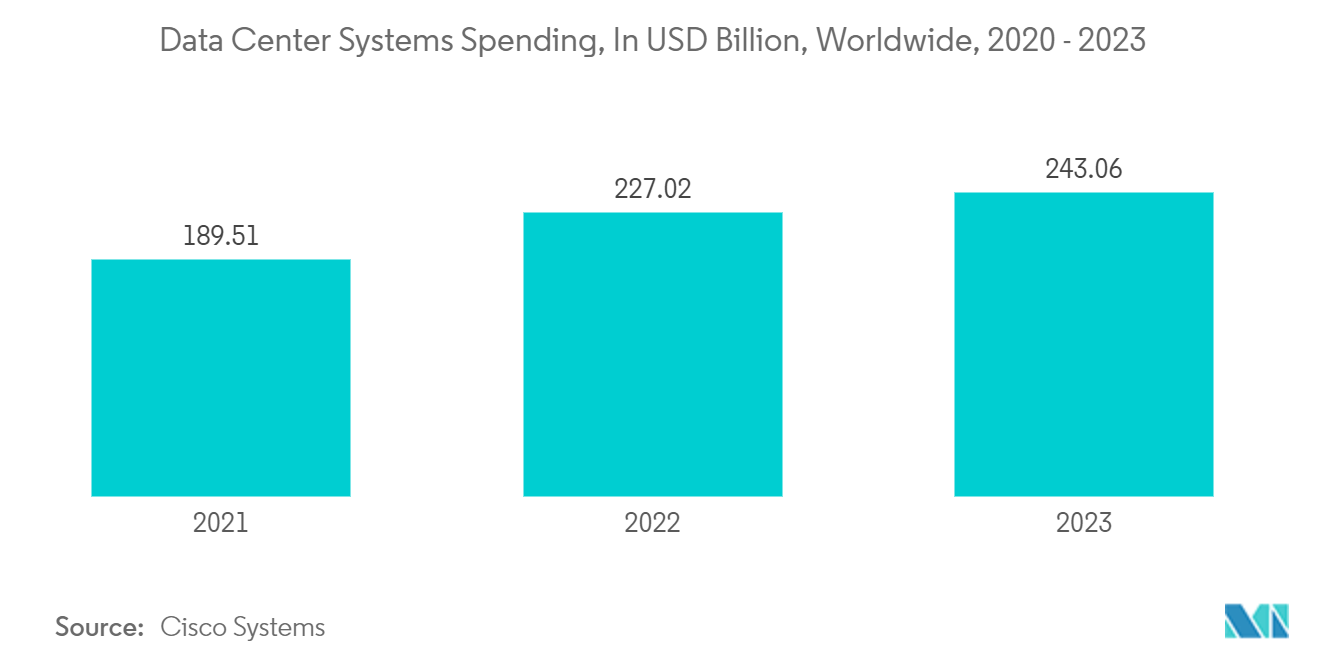
North America Occupies the Largest Market Share
- The country's next-generation storage market will witness a high growth rate due to the increasing regional concentration of global vendors and consumers.
- The United States remains one of the top markets for data centers globally. Also, in April 2022, Google announced plans to invest USD 9.5 billion in data centers and offices nationwide. The tech giant will be building or expanding 14 data centers in the US states like Georgia, Texas, New York, and California, among others. Such increasing investments in data centers are also creating considerable growth opportunities for the market.
- Moreover, the data-heavy Internet of Things (IoT) devices constitute another emerging market for next-generation storage. These applications primarily cover a wide range. Industrial automation in the form of Factory 4.0 is one segment. Still, the IoT also includes wearables, healthcare, aviation, plus about anything that begins with smart, such as smart homes, smart farms, smart metering, and smart logistics, among others.
- According to a Stanford University and Avast study, homes in the North American region have the highest density of IoT devices installed worldwide. Notably, 66% of households in the region have at least one of her IoT devices. Additionally, 25% of North American homes have three or more devices.
- Additionally, increasing Internet traffic and user-generated data contribute to the market growth, with North America having the highest volume of IP traffic. According to CISCO, IP traffic in the region will reach 108.4 EB per month by 2022.
- According to Ericsson's report, the average monthly mobile data usage per smartphone is likely to reach 55 GB in 2028 in North America. The improved 5G network and unlimited data plans will attract more 5G subscribers in the region. Video-based apps, virtual/augmented reality, and gaming generate huge data traffic. In 2028, the company predicts that 5G subscriptions in North America will be more than 90%world's, the highest among all regions.
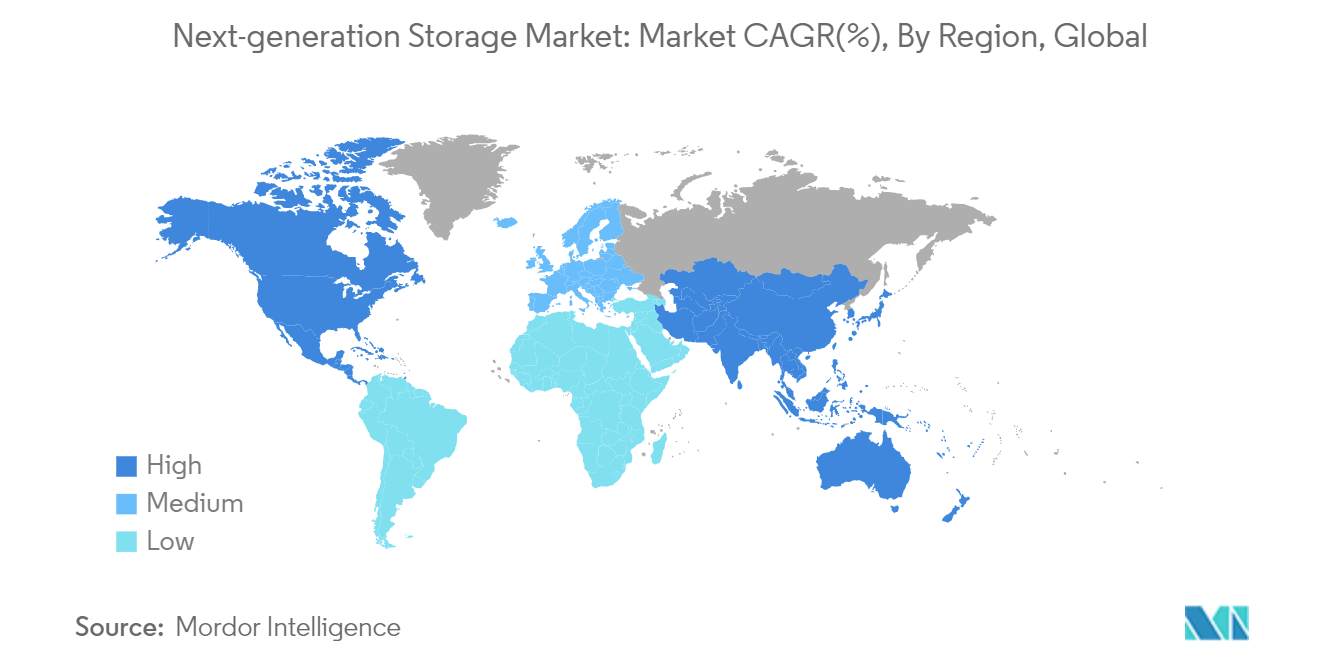
Competitive Landscape
The next-generation storage market is semi-consolidated and consists of some major players. In terms of market share, few of the key players currently dominate the market. However, with innovation in memory packaging technology, many companies are increasing their market presence across untapped new markets of emerging economies.
- May 2023 - NetApp announced a new modern block storage offering and a guarantee highlighting NetApp's best-in-class ability to recover from ransomware attacks. Through this launch, the company aims to address critical customer challenges, including restricted IT budgets, increasing IT complexity, increased urgency around sustainability, and the continued exponential growth of cyber threats.
- April 2023 - Pure Storage Inc. announced introducing a next-generation unified block and file storage service. This new storage service provides access to native block and file services from a single, global pool of resources. A unified storage architecture supports block and file storage formats, allowing organizations to store and view data in various ways.
Next-generation Storage Industry Leaders
-
Dell Inc.
-
Hewlett Packard Enterprise Company
-
NetApp Inc.
-
Hitachi Ltd
-
IBM Corporation
- *Disclaimer: Major Players sorted in no particular order
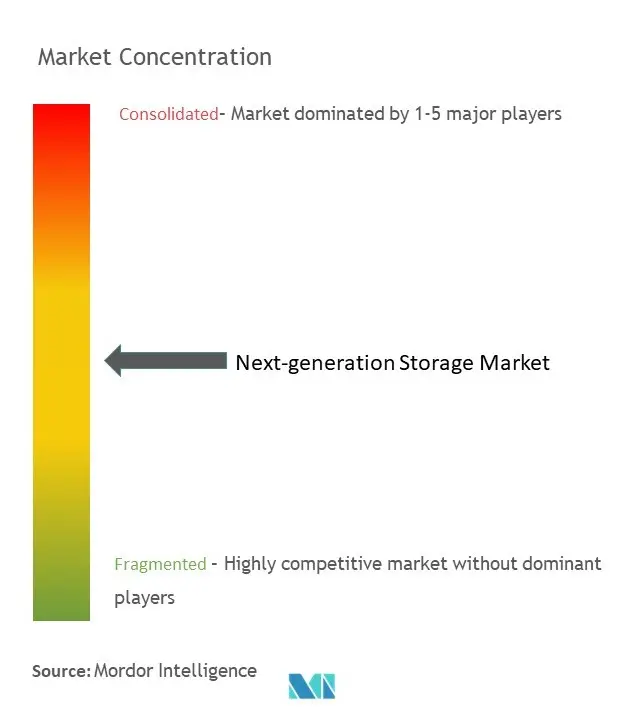
Recent Industry Developments
- September 2023 - Kioxia introduced Next Generation higher performing JEDEC e-MMC Ver. 5.1-compliant embedded flash memory products for consumer applications. The new products integrate a newer version of the company’s BiCS FLASH 3D flash memory and a controller in a single package, reducing processor workload and improving ease of use. It will be available in both 64 and 128 gigabytes.
- July 2023 - Samsung Electronics announced the completion of the development of the industry’s first Graphics Double Data Rate 7 (GDDR7) DRAM. It will first be installed in next-generation systems of key customers for verification. Following Samsung’s 24Gbps GDDR6 DRAM in 2022, the company’s 16-gigabit (Gb) GDDR7 offering will deliver the industry’s highest speed. It will elevate user experiences requiring outstanding graphics performance, such as workstations, PCs, and game consoles. It is expected to expand into future applications such as AI, high-performance computing (HPC), and automotive vehicles.
Global Next-generation Storage Market Report Scope
Next-generation data storage includes advanced products and solutions for growing file sizes and massive amounts of unstructured data. The next-generation data storage technology products manage large data securely and enable secure, reliable, and fast recovery of data in a cost-efficient manner. End-user Industries, such as BFSI, healthcare, and IT and telecom, need next-generation storage devices owing to the massive volume of data generated in their businesses.
The Next-generation storage market is segmented by storage system (direct attached storage (das), network attached storage (NAS), storage area network (san)), storage architecture (file and object-based storage (fobs), block storage), end-user industry (BFSI, retail, it and telecom, healthcare, media, and entertainment), and geography (North America, Europe, Asia Pacific, Latin America, and Middle East and Africa). The report offers the market size in value terms in USD for all the abovementioned segments.
| Direct Attached Storage (DAS) |
| Network Attached Storage (NAS) |
| Storage Area Network (SAN) |
| File and Object-based Storage (FOBS) |
| Block Storage |
| BFSI |
| Retail |
| IT and Telecom |
| Healthcare |
| Media and Entertainment |
| Other End-user Industries |
| North America |
| Europe |
| Asia Pacific |
| Rest of the World |
| Storage System | Direct Attached Storage (DAS) |
| Network Attached Storage (NAS) | |
| Storage Area Network (SAN) | |
| Storage Architecture | File and Object-based Storage (FOBS) |
| Block Storage | |
| End User Industry | BFSI |
| Retail | |
| IT and Telecom | |
| Healthcare | |
| Media and Entertainment | |
| Other End-user Industries | |
| Geography | North America |
| Europe | |
| Asia Pacific | |
| Rest of the World |
Key Questions Answered in the Report
How big is the Next-generation Storage Market?
The Next-generation Storage Market size is expected to reach USD 71.58 billion in 2025 and grow at a CAGR of 7.37% to reach USD 102.15 billion by 2030.
What is the current Next-generation Storage Market size?
In 2025, the Next-generation Storage Market size is expected to reach USD 71.58 billion.
Who are the key players in Next-generation Storage Market?
Dell Inc., Hewlett Packard Enterprise Company, NetApp Inc., Hitachi Ltd and IBM Corporation are the major companies operating in the Next-generation Storage Market.
Which is the fastest growing region in Next-generation Storage Market?
Asia Pacific is estimated to grow at the highest CAGR over the forecast period (2025-2030).
Which region has the biggest share in Next-generation Storage Market?
In 2025, the North America accounts for the largest market share in Next-generation Storage Market.
What years does this Next-generation Storage Market cover, and what was the market size in 2024?
In 2024, the Next-generation Storage Market size was estimated at USD 66.30 billion. The report covers the Next-generation Storage Market historical market size for years: 2019, 2020, 2021, 2022, 2023 and 2024. The report also forecasts the Next-generation Storage Market size for years: 2025, 2026, 2027, 2028, 2029 and 2030.
Page last updated on:
Next-generation Storage Market Report
Statistics for the 2025 Next-generation Storage market share, size and revenue growth rate, created by Mordor Intelligence™ Industry Reports. Next-generation Storage analysis includes a market forecast outlook for 2025 to 2030 and historical overview. Get a sample of this industry analysis as a free report PDF download.
